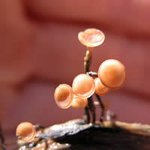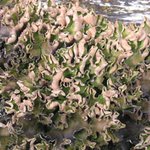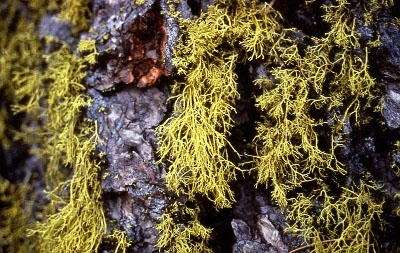What is a lichen?
Contents
Introduction
A lichen is a complex life form that is a symbiotic partnership (What is a lichen?) of two separate organisms, a fungus and an alga. The dominant partner is the fungus, which gives the lichen the majority of its characteristics, from its thallus shape to its fruiting bodies. The alga can be either a green alga or a blue-green alga, otherwise known as cyanobacteria. Many lichens will have both types of algae.
Have you ever seen a lichen,L and knew that it was a lichen? Not many people know what lichens are, and who would? They seem as though they are from another planet! Lichens are bizarre organisms and no two are alike.
What are fungi?

Fungi are a diverse group of organisms that are in their own kingdom (Fungi), separate from plants. Fungi do not contain chlorophyll or any other means of producing their own food so they rely on other organisms for nutrition. Fungi are widely known for their role in the decomposition of organic matter. They are also necessary for the survival of the ecosystem around them, such as partnering with plants and trees for nutrients and survival.
Lichens are another such partnership for fungi to gain nutrients from another organism. The algal partner photosynthesizes and provides food for the fungus, so it can grow and spread.
What are algae?

Algae are in another kingdom (Protista) separate from plants and fungi. There are several types of algae: green, brown, red, gold. They can survive in salt water and in freshwater on their own, and in any environment when part of a lichen relationship.
Although cyanobacteria are called blue-green algae, they are actually bacteria, and are part of the bacteria kingdom, Monera. The "blue" in the common name refers to the fact that they need to live in water, and "green algae" refers to their photosynthetic abilities, like green algae.
What Lichens Are Not
Isn't lichen that mossy stuff on rocks and trees? When people think of lichens, many of them think of them as a kind of moss. That could not be farther from the truth.
Although moss and lichens are both called non-vascular plants, only mosses are plants. Mosses are included in a group of non-vascular plants called bryophytes. Mosses are believed to be the ancestors of the plants we see today, like trees, flowers, and ferns. Lichens, on the other hand, are not similar in anyway to mosses or other members of the plant kingdom.
Although mosses are very primitive, they still have plant-like structures that look like and function like leaves, stems and roots. They have chloroplasts throughout their entire bodies and can photosynthesize from all sides of their structures.
Lichens, on the other hand, are completely different. They do not have any roots, stems or leaves and their chloroplasts are contained only in the algae on the top surface of the lichen.
What lichens and mosses do have in common are size and habitats. In fact, mosses retain water, which is what lichens use to prolong their growth cycle.
So, the next time you see a bunch of "mossy" stuff hanging from a tree or sitting on a rock, ask yourself, "Is that a lichen or a moss?"
Why are lichens important?
Lichens are important for several reasons. One of the most obvious is that they are beautiful to look at. How enchanting would the Pacific Northwest be without the long drapes of Alectoria sarmentosa (witch’s hair) hanging from the branches of the old Douglas firs and Sitka spruce? How colorful would the rocks and cliffs be in the Rocky Mountains without the reds, yellows, and greens of the crust lichens? Without these living creatures hanging off of trees or clinging to rocks, our natural areas would look pretty boring and a little more lifeless.
Another important function of lichens is that they provide a mode of survival in harsh environments where algae cannot normally survive. Since the fungus can protect its algae, these normally water-requiring organisms can live in dry, sunny climates without dying, as long as there are occasional rain showers or flooding to let them recharge and store food for the next drought period. Because lichens enable algae to live all over the world in many different climates, they also provide a means to convert carbon dioxide in the atmosphere through photosynthesis into oxygen, which we all need to survive.
One of the ways lichens directly benefit humans is through their ability to absorb everything in their atmosphere, especially pollutants. Lichens can provide us with valuable information about the environment around us. Any heavy metals or carbon or sulfur or other pollutants in the atmosphere are absorbed into the lichen thallus. Scientists can extract these toxins and determine the levels that are present in our atmosphere. The United States Forest Service National Lichens and Air Quality Database and Clearinghouse provides more information about lichen biomonitoring and how it is helping federal land managers meet federal and agency responsibilities to detect, map, evaluate trends, and assess the ecological impacts of air pollutants.
